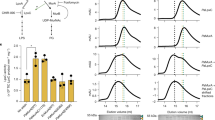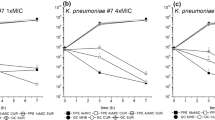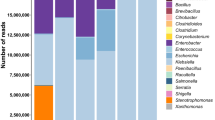Abstract
Pulmonary surfactant is inactivated in meconium aspiration syndrome and neonatal pneumonia. Development of an exogenous surfactant less sensitive to inactivation might be useful for treating these diseases. We investigated in vitro whether addition of the cationic cyclic membrane cross-linking peptide polymyxin B (PxB) and/or calcium chloride (CaCl2) to modified porcine surfactant Curosurf increases resistance to meconium-induced inactivation of surface activity while antimicrobial activity of PxB is maintained. To study bacterial proliferation, Escherichia coli, group B streptococci (GBS), or Staphylococcus aureus were incubated 0–5 h in saline or in meconium in the presence or absence of Curosurf with or without PxB. PxB and CaCl2 improved spreading and adsorption of Curosurf. Curosurf plus CaCl2/PxB needed a 4-fold increase of meconium concentration to increase dynamic surface tension significantly compared with Curosurf plus CaCl2 alone, indicating that PxB further increases the resistance of Curosurf to meconium-induced inactivation. Meconium alone like meconium/Curosurf promoted growth of E. coli and GBS, but addition of Curosurf/PxB or PxB alone significantly reduced the growth of E. coli. Biophysical and antibacterial properties of Curosurf and PxB may be combined into a useful adjunct in the treatment of neonatal Gram-negative pneumonia and/or meconium aspiration syndrome.
Similar content being viewed by others
Log in or create a free account to read this content
Gain free access to this article, as well as selected content from this journal and more on nature.com
or
Abbreviations
- CFU:
-
colony-forming units
- DPPC:
-
dipalmitoylphosphatidylcholine
- LPS:
-
lipopolysaccharide
- MAS:
-
meconium aspiration syndrome
- PBS:
-
pulsating bubble surfactometer
- PxB:
-
polymyxin B
- SP:
-
surfactant protein
- γ:
-
surface tension
References
Moses D, Holm BA, Spitale P, Liu M, Enhorning G 1991 Inhibition of pulmonary surfactant by meconium. Am J Obstet Gynecol 164: 477–481
Sun B, Curstedt T, Song GW, Robertson B 1993 Surfactant improves lung function and morphology in newborn rabbits with meconium aspiration. Biol Neonate 63: 96–104
Findlay RD, Taeusch HW, Walther FJ 1996 Surfactant replacement therapy for meconium aspiration syndrome. Pediatrics 97: 48–52
Herting E, Rauprich P, Stichtenoth G, Walter G, Johansson J, Robertson B 2001 Resistance of different surfactant preparations to inactivation by meconium. Pediatr Res 50: 44–49
Johansson J, Curstedt T, Robertson B 2001 Artificial surfactants based on analogues of SP-B and SP-C. Pediatr Pathol Mol Med 20: 501–518
Mifsud AJ, Efstratiou A, Charlett A, McCartney AC . Health Protection Agency Group B Streptococcus Working Group. 2004 Early-onset neonatal group B streptococcal infection in London: 1990–1999. BJOG 111: 1006–1011
Healy CM, Palazzi DL, Edwards MS, Campbell JR, Baker CJ 2004 Features of invasive staphylococcal disease in neonates. Pediatrics 114: 953–961
Cordero L, Rau R, Taylor D, Ayers LW 2004 Enteric Gram-negative bacilli bloodstream infections: 17 years' experience in a neonatal intensive care unit. Am J Infect Control 32: 189–195
Herting E, Sun B, Jarstrand C, Curstedt T, Robertson B 1997 Surfactant improves lung function and mitigates bacterial growth in immature ventilated rabbits with experimentally induced neonatal group B streptococcal pneumonia. Arch Dis Child Fetal Neonatal Ed 76: 3–8
Herting E, Gefeller O, Land M, van Sonderen L, Harms K, Robertson B 2000 Surfactant treatment of neonates with respiratory failure and group B streptococcal infection. Members of the Collaborative European Multicenter Study Group. Pediatrics 106: 957–964
Evans ME, Feola DJ, Rapp RP 1999 Polymyxin B sulfate and colistin: old antibiotics for emerging multiresistant Gram-negative bacteria. Ann Pharmacother 33: 960–967
Zaltash S, Palmblad M, Curstedt T, Johansson J, Persson B 2000 Pulmonary surfactant protein B: a structural model and a functional analogue. Biochim Biophys Acta 1466: 179–186
Enhorning G 1977 Pulsating bubble technique for evaluating pulmonary surfactant. J Appl Physiol 43: 198–203
Notter RH, Tabak SA, Mavis RD 1980 Surface properties of binary mixtures of some pulmonary surfactant components. J Lipid Res 21: 10–22
Rebello CM, Jobe AH, Eisele JW, Ikegami M 1996 Alveolar and tissue surfactant pool sizes in humans. Am J Respir Crit Care Med 154: 625–628
Schmalisch G, Wauer RR 1993 [Percentile curves of functional residual capacity of newborn infants.]. Monatsschr Kinderheilkd 141: 714–720
Brace RA, Wolf EJ 1989 Normal amniotic fluid volume changes throughout pregnancy. Am J Obstet Gynecol 161: 382–388
Aziz S, Leroy P, Servaes R, Eggermont E, Fevery J 2001 Bilirubin-IXbeta is a marker of meconium, like zinc coproporphyrin. J Pediatr Gastroenterol Nutr 32: 287–292
Calkovska A, Some M, Linderholm B, Johansson J, Curstedt T, Robertson B 2005 Biophysical and physiological properties of porcine surfactant enriched with polymyxin B. Biol Neonate 88: 101–108
Kobayashi T, Shido A, Nitta K, Inui S, Ganzuka M, Robertson B 1990 The critical concentration of surfactant in fetal lung liquid at birth. Respir Physiol 80: 181–192
Taeusch HW 2000 Treatment of acute (adult) respiratory distress syndrome. The holy grail of surfactant therapy. Biol Neonate 77: 2–8
Sun B, Curstedt T, Robertson B 1993 Surfactant inhibition in experimental meconium aspiration. Acta Paediatr 82: 182–189
Tashiro K, Cui XG, Kobayashi T, Curstedt T, Robertson B 2003 Modified protocols for surfactant therapy in experimental meconium aspiration syndrome. Biol Neonate 83: 49–56
William Taeusch H, Lu KW, Goerke J, Clements JA 1999 Nonionic polymers reverse inactivation of surfactant by meconium and other substances. Am J Respir Crit Care Med 159: 1391–1395
Lu KW, Goerke J, Clements JA, Taeusch HW 2005 Hyaluronan decreases surfactant inactivation in vitro. Pediatr Res 57: 237–241
Sun B, Curstedt T, Lindgren G, Franzen B, Alaiya AA, Calkovska A, Robertson B 1997 Biophysical and physiological properties of a modified porcine surfactant enriched with surfactant protein A. Eur Respir J 10: 1967–1974
Schurch S, Qanbar R, Bachofen H, Possmayer F 1995 The surface-associated surfactant reservoir in the alveolar lining. Biol Neonate 67: 61–76
Cajal Y, Ghanta J, Easwaran K, Surolia A, Jain MK 1996 Specificity for the exchange of phospholipids through polymyxin B mediated intermembrane molecular contacts. Biochemistry 35: 5684–5695
Veldhuizen EJ, Batenburg JJ, van Golde LM, Haagsman HP 2000 The role of surfactant proteins in DPPC enrichment of surface films. Biophys J 79: 3164–3171
Rauprich P, Moller O, Walter G, Herting E, Robertson B 2000 Influence of modified natural or synthetic surfactant preparations on growth of bacteria causing infections in the neonatal period. Clin Diagn Lab Immunol 7: 817–822
Bryan SC 1967 Enhancement of bacterial infection by meconium. Johns Hopkins Med J 121: 9–13
Florman AL, Teubner D 1969 Enhancement of bacterial growth in amniotic fluid by meconium. J Pediatr 74: 111–114
Eidelman AI, Nevet A, Rudensky B, Rabinowitz R, Hammerman C, Raveh D, Schimmel MS 2002 The effect of meconium staining of amniotic fluid on the growth of Escherichia coli and group B streptococcus. J Perinatol 22: 467–471
Lembet A, Gaddipati S, Holzman IR, Berkowitz RL, Bottone EJ 2003 Meconium enhances the growth of perinatal bacterial pathogens. Mt Sinai J Med 70: 126–129
Horton J, Pankey GA 1982 Polymyxin B, colistin, and sodium colistimethate. Med Clin North Am 66: 135–142
Marier JF, Brazier JL, Lavigne J, Ducharme MP 2003 Liposomal tobramycin against pulmonary infections of Pseudomonas aeruginosa: a pharmacokinetic and efficacy study following single and multiple intratracheal administrations in rats. J Antimicrob Chemother 52: 247–252
Omri A, Suntres ZE, Shek PN 2002 Enhanced activity of liposomal polymyxin B against Pseudomonas aeruginosa in a rat model of lung infection. Biochem Pharmacol 64: 1407–1413
McAllister SM, Alpar HO, Brown MR 1999 Antimicrobial properties of liposomal polymyxin B. J Antimicrob Chemother 43: 203–210
Morrison DC, Jacobs DM 1976 Binding of polymyxin B to the lipid A portion of bacterial lipopolysaccharides. Immunochemistry 13: 813–818
Augusto L, Le Blay K, Auger G, Blanot D, Chaby R 2001 Interaction of bacterial lipopolysaccharide with mouse surfactant protein C inserted into lipid vesicles. Am J Physiol Lung Cell Mol Physiol 281: 776–785
Author information
Authors and Affiliations
Corresponding author
Additional information
Supported by the Swedish Research Council (Project No. 3351), King Oscar II's Jubilee Foundation, and the German Research Council (DFG He 2072/2–2).
Rights and permissions
About this article
Cite this article
Stichtenoth, G., Jung, P., Walter, G. et al. Polymyxin B/Pulmonary Surfactant Mixtures Have Increased Resistance to Inactivation by Meconium and Reduce Growth of Gram-Negative Bacteria In Vitro. Pediatr Res 59, 407–411 (2006). https://doi.org/10.1203/01.pdr.0000200806.32822.e6
Received:
Accepted:
Issue date:
DOI: https://doi.org/10.1203/01.pdr.0000200806.32822.e6
This article is cited by
-
Restoration of surfactant activity by polymyxin B in lipopolysaccharide-potentiated injury of immature rabbit lungs
Scientific Reports (2021)
-
Bronchoalveolar lavage with pulmonary surfactant/dextran mixture improves meconium clearance and lung functions in experimental meconium aspiration syndrome
European Journal of Pediatrics (2008)
-
Deleted in Malignant Brain Tumors 1 (DMBT1) is present in hyaline membranes and modulates surface tension of surfactant
Respiratory Research (2007)
-
What’s new in surfactant?
European Journal of Pediatrics (2007)
-
The respiratory distress syndrome (RDS) in preterm infants
Intensivmedizin und Notfallmedizin (2007)



